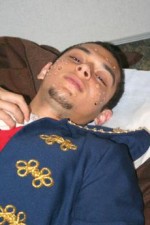One sickening class

Tuberculosis, smallpox, the plague and other deadly diseases put several students on their deathbeds Tuesday morning – but for an educational purpose.
Johnny El-Rady, a USF instructor, and students in his Major Works and Major Issues honors class created a theatrical walk-through of diseases of the past, present and future.
“The objectives are twofold,” El-Rady said. “One is that they learn, and the second is that they make someone else learn.”
Students spent the first half of the spring semester researching diseases and the second half planning the project.
With the help of the University’s theater program, the class mimicked the effects of the plague, tuberculosis, smallpox, cholera, malaria, HIV/AIDS and avian flu.
Christopher Smith, a sophomore biomedical science major, doctored a woman with bubonic plague lying stiffly on a bed.
Bubonic plague is caused by a bacteria found in fleas that lived on black rats in Europe. Those fleas transmitted the disease to humans when they bit them.
Smith said doctors in the 17th century mistakenly suspected the disease was caused by bad air.
As Smith held a scented candle and threw flowers onto the women’s body, he explained how doctors treated the disease.
“They thought they could ward it off with strong smells,” he said.
To protect himself from being infected with bubonic plague, Smith wore a long gown, a hat and a beak that doctors often stuffed with strong scents to purify the air they breathed.
Many doctors died because they were in close contact with plague victims.
Nearby, a woman with tuberculosis coughed violently into a blood-soaked handkerchief.
Tuberculosis traces its roots to ancient Egypt and became the leading cause of death in Europe during the 18th century.
At the next station, a nurse tended to a uniformed soldier with smallpox, the diseased marked by the red blisters on his face. The first vaccine ever created treated people by making them immune to smallpox before they were infected.
A vomit-filled pan sat near a cholera victim in the next bed. Cholera, characterized by severe loss of bodily fluids, is an intestinal infection dating back to Sanskrit writings in 450 B.C.
According to diseasehascome.com, a Web site created by the class, cholera can still be found in developing areas of the world with contaminated water.
On the other side of the walk-through, a camper starting a fire was distracted by the buzz of mosquitoes. Malaria, a mosquito-borne disease caused by a parasite, kills more than a million people each year, according to the Centers for Disease Control and Prevention Web site.
Another performer sat in front of a table covered with pills and a spoon for taking drugs. He took a swig from a flask and let his head fall back. Intravenous drug use was what infected him with HIV and, eventually, AIDS.
The last area was quarantined with orange barriers and caution signs. A man inside struggled with a squawking rubber chicken suffering from avian flu, or the bird flu.
Brian Smith, a junior history major, introduced himself as “Death.” While avian flu is most common in domestic birds like chickens and ducks, he said human contamination is possible.
“It’s rare, but it’s still something to look out for,” he said.





